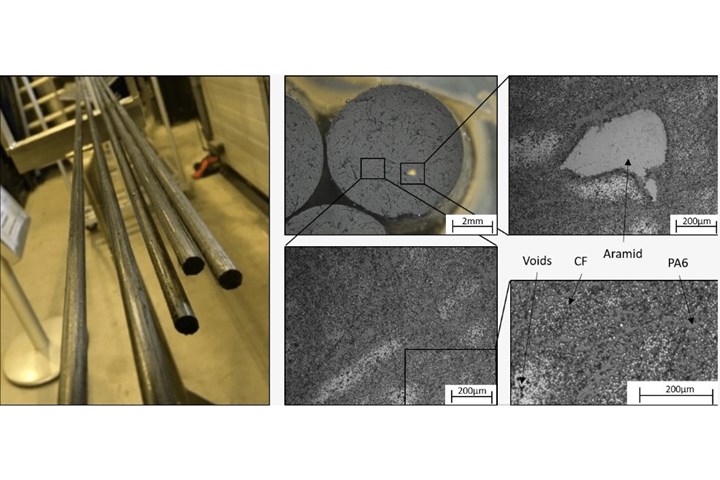FLOTANT project to develop composite mooring cable system for deep water wind farms
Project partners are testing pultruded carbon fiber/thermoplastic profiles for use in a more cost-efficient, robust offshore wind farm mooring system.

Source | Institut für Textiltechnik of RWTH Aachen University
The Institut für Textiltechnik of RWTH Aachen University (ITA, Aachen, Germany) has teamed with 17 partner organizations to develop a concept and basic engineering for a hybrid concrete/thermoplastic composite floating structure designed for deep water wind farms.
In the FLOTANT project, project partners TFI Marine (Dublin, Ireland) and Future Fibres (Alcàsser, Spain), along with ITA, will lead the design concept for a wind farm mooring system based on the use of high-performance carbon fiber/thermoplastic mooring cables. Goals include improving cost-efficiency, flexibility and robustness of the system, and project partners aim at deployment in water depths from 100-600 meters which ITA says would optimize the levelized cost of energy (LCOE) of the floating system (€85-95 per megawatt-hour by 2030). Project partner AIMPLAS (Paterna, Spain), supported by ITA, will implement the power cable and mooring system.
For mooring cable design, ITA developed a new process for the pultrusion of thermoplastic profile components based on pre-impregnated reinforcing fibers (TP-Profiles). This process is said to allow the continuous production of unidirectional reinforced rods based on carbon fiber (CF) and polyamide (PA6). Requirements under consideration included the ability to withstand an aggressive saltwater environment, high mechanical requirements, the capability for sensor integration, and safety for the ocean ecosystem.
In the first stage of process development, ITA says that it reached a 14-hour circle of continuous production. A completely impregnated and consolidated TP-Profile could be produced over the entire period. In the next step, these profiles are being tested for the required mechanical properties, and the cable design for the high loads of mooring offshore platforms will be developed. During the second half of 2020, a component will be developed to help protect flora around the wind farm. The pultrusion process is expected to be up-scaled to an industrial scale by the end of 2021.
Related Content
-
Novel dry tape for liquid molded composites
MTorres seeks to enable next-gen aircraft and open new markets for composites with low-cost, high-permeability tapes and versatile, high-speed production lines.
-
Materials & Processes: Fabrication methods
There are numerous methods for fabricating composite components. Selection of a method for a particular part, therefore, will depend on the materials, the part design and end-use or application. Here's a guide to selection.
-
Materials & Processes: Composites fibers and resins
Compared to legacy materials like steel, aluminum, iron and titanium, composites are still coming of age, and only just now are being better understood by design and manufacturing engineers. However, composites’ physical properties — combined with unbeatable light weight — make them undeniably attractive.

.jpg;width=70;height=70;mode=crop)











